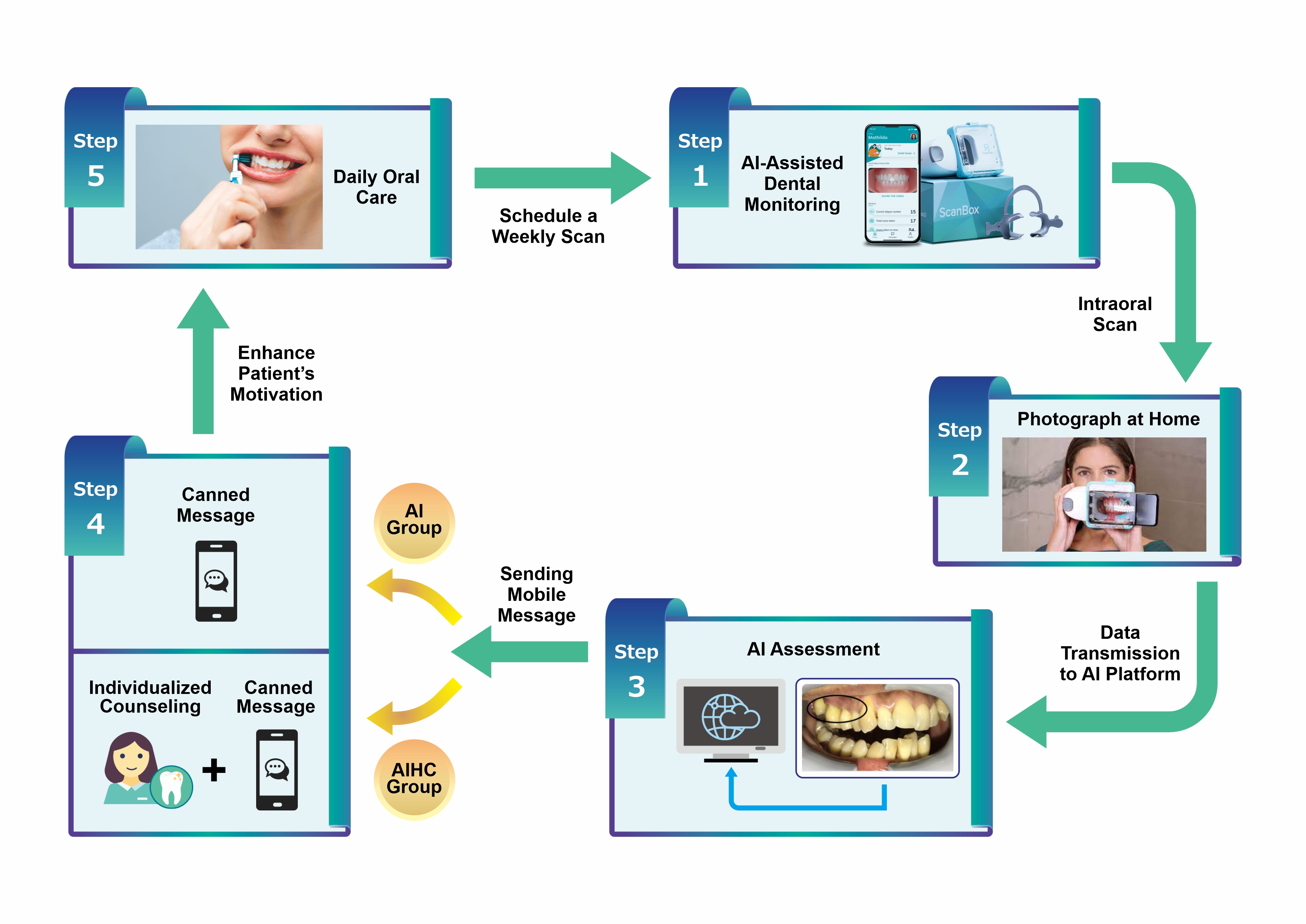使用人工智慧AI牙科監測系統對患者牙周病治療之成效
使用人工智慧AI牙科監測系統對患者牙周病治療之成效
牙周病是全球常見的牙科疾病之一,在台灣超過54%的人患有牙周病,其中35 歲以上成年人的患病率上升。牙周病主要是由口腔衛生不良導致的牙菌斑堆積所引起的。提高患者口腔自我照護行為對於降低牙菌斑和牙周治療成效至關重要。
人工智慧 (Artificial Intelligence; AI) 是指系統或機器人結合大數據進行自我學習,不僅可以模仿人類來執行任務還可以根據收集到的訊息進行自我調整,通過計算進而做出決策。AI可以節省用於重複性任務的人工成本讓牙科人員騰出時間來照顧更多患者。在這個計畫中,我們利用人工智慧平台DENTAL MONITORING® (DM) 作為監控工具。此AI監測產品利用智能手機攝像頭進行掃描,不僅檢查患者的牙齦、口腔黏膜和牙齒狀況,還可以判斷患者的口腔衛生是否良好。定期的AI提醒增加與患者的溝通,並且可以為患者量身制定的建議和提醒,容易操作,在家就可自我照護,並提醒患者定期看牙醫,增加看牙醫的頻率。本研究為第一個以AI牙科監測系統作為口腔健康諮詢的輔助工具,目的是驗證居家AI 牙科監測平台是否可以提高患者牙菌斑控制和牙周治療的成效。
本研究招募牙周病患者,將他們隨機分配到三個組別:分別是 AI組(n = 16)、AI 合併健康諮詢組 (AIHC; n = 17)或對照組(n = 20)。所有三組參與者都接受非手術性牙周治療(包括牙齦下牙結石刮除及牙根整平術)。AI 與AIHC兩組的患者使用 AI平台,結合智慧型手機相機進行口腔內掃描與評估;AIHC組的患者額外接受口衛師健康諮詢達三個月的時間。收集患者牙周囊袋深度(probing pocket depth; PPD)、臨床附連喪失(clinical attachment loss; CAL)和牙菌斑指數進行前後測資料分析。
研究結果發現使用居家 AI牙科監測系統來提醒患者在家維持良好的口腔衛生習慣,可以有效降低牙菌斑堆積並提升牙周病治療之成效;患者於AI介入後牙周狀況呈現較淺的牙周囊袋深度和臨床附連喪失。此外,相較於單獨使用AI的患者,結合AI與口衛師健康諮詢的組別有更低的牙菌斑指數及較佳的牙周治療成效。

AI介入流程圖
應用與亮點:
1.國際上第一個以AI牙科監測系統作為口腔健康諮詢輔助工具的介入研究。
2.透過AI作為居家提醒和影像評估,可增加牙周病患者的口腔衛生行為之依從性,進而減少牙菌斑堆積,提升患者牙周病治療
成效。
【研究團隊】
團隊成員:黃曉靈(計畫主持人) 、黃炯霖、申岡陵、林盈諄、杜哲光、陳富莉、Yuji Kabasawa、陳志章
代表單位:高雄醫學大學口腔醫學院口腔衛生學系
團隊簡介:本研究由口腔衛生學系黃曉靈教授(計畫主持人)口腔健康促進與照護實驗室、高醫大附設醫院牙科部杜哲光部長與黃炯霖主任、及口腔醫學院姊妹校日本東京醫科齒科大學Yuji Kabasawa教授共同合作完成。研究經費由109及110年度科技部計畫(MOST109-2314-B037-074, MOST110-2314-B-037-037-MY2)支持。
研究聯繫Email:hhuang@kmu.edu.tw
【論文資訊】
論文出處:Journal of Clinical Periodontology, June 17 2022; Issue 10 (Volume 49): p. 988-998
全文下載:https://doi.org/10.1111/jcpe.13675
Effects of Artificial Intelligence-assisted Dental Monitoring Intervention in Patients with Periodontitis: A Randomized Controlled Trial
Effects of Artificial Intelligence-assisted Dental Monitoring Intervention in Patients with Periodontitis: A Randomized Controlled Trial
Periodontal disease, caused by dental plaque, is the leading cause of tooth loss in adults over 35 years of age. Dental plague continues to form on the surface of the teeth and contains bacteria that release toxins and damage the gums and alveolar bone. Strengthening periodontal disease patients to adherence to oral care behaviors and reduce plaque index is indispensable in the treatment of periodontal disease. In this project, we employed an AI platform as our monitoring tool: DENTAL MONITORING® (DM). This is a new technological AI monitoring product that utilizes smartphone cameras for scanning, which not only checks the conditions of a patient’s gums, mucous, and teeth but also determines whether the patient has good oral hygiene. The AI application is easy to operate, can help patients observe their own oral conditions at home, and reminds patients to make an appointment with a dentist, the latter of which increases the frequency of dental visits. Our aim was to examine the effects of homecare AI on the plaque control and periodontal treatment in patients with periodontal disease.
The newly diagnosed patients in the periodontology department were recruited and randomly assigned into three groups: the AI group (AI; n = 16), the AI & humanized counseling group (AIHC; n = 17), or the control group (CG; n = 20). All participants received clinical non-surgical periodontal therapy (scaling and root planing) and one-to-one oral hygiene instruction. The participants in AI group used the AI platform to provide AI assessment and reminder. The participants in AIHC group received the AI monitoring and additional oral health counseling by a consultant. Baseline and follow-ups periodontal status were collected including plaque index (PI), gingival index (GI), probing pocket depth (PPD), clinical attachment loss (CAL).
After intervention, the AI and AIHC groups exhibited significantly greater improvement in probing pocket depth, clinical attachment level and plaque index (all P < 0.05) at 3-month follow-up than the CG did. Patients of the AI-assisted health consultation showed better treatment outcomes and plaque control than patients who used AI platform alone.

AI intervention flowchart
Application and Highlights:
1.This is the first study to employ an AI smartphone monitoring platform as a tool for oral health
consultation and intervention.
2.AI-assisted dental monitoring can be used in clinical practices to strengthen adherence to preventive behaviors after periodontal surgeries in order to reduce plaque and improve treatment outcomes.
Research Team Members: Hsiao-Ling Huang, DrPH (Principal investigator), Kang-Ling Shen, MS, Chiung-Lin Huang, DDS, Ying-Chun Lin, PhD, Je-Kang Du, DDS, PhD, Fu-Li Chen, PhD, Yuji Kabasawa, DDS, PhD, Chih-Chang Chen, MS.
Representative Department: Department of Oral Hygiene, College of Dental Medicine.
Introduction of Research Team: This study was conducted jointly by the Oral Health Promotion and Care Lab in Department of Dental Hygiene in Kaohsiung Medical University, Division of Periodontics in Department of Dentistry in Kaohsiung Medical University Hospital, and School of Oral Health Care Sciences in Tokyo Medical and Dental University in Japan. This work was supported by the Ministry of Science and Technology, Taiwan [grant number MOST109-2314-B037-074, MOST110-2314-B-037-037-MY2].
Contact Email: hhuang@kmu.edu.tw
Publication: Journal of Clinical Periodontology, June 17 2022; Issue 10 (Volume 49): p. 988-998
Full-Text Article: https://doi.org/10.1111/jcpe.13675

